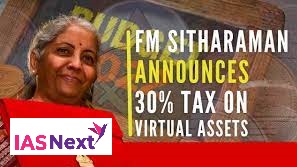CURRENT AFFAIRS
Get the most updated and recent current affair content on Padhaikaro.com
What are virtual digital assets?
- IAS NEXT, Lucknow
- 04, Feb 2022

Reference News:-
Finance Minister Nirmala Sitharaman, in her Budget 2022 speech (February 1), announced a 30 per cent tax on income from virtual digital assets.
Rationale behind:
There has been a phenomenal rise in such transactions and the magnitude and frequency of these transactions have made it imperative to provide for a specific tax regime.
What are virtual digital assets and how are they different from digital currency?
In simple words, it basically means cryptocurrencies, DeFi (decentralised finance) and non-fungible tokens (NFTs). Prima facie, this excludes digital gold, central bank digital currency (CBDC) or any other traditional digital assets, and hence aimed at specifically taxing cryptocurrencies.
As per the Finance Bill, a virtual digital asset is proposed to mean any information or code or number or token (not being Indian currency or any foreign currency), generated through cryptographic means or otherwise, by whatever name called, providing a digital representation of value which is exchanged with or without consideration, with the promise or representation of having inherent value, or functions as a store of value or a unit of account and includes its use in any financial transaction or investment, but not limited to, investment schemes and can be transferred, stored or traded electronically.
- Non fungible token and; any other token of similar nature are included in the definition.”
Does the 30% tax mean crypto assets have been legalised in India?
A tax law can’t make anything legal or illegal—that has to be done via a separate statute.